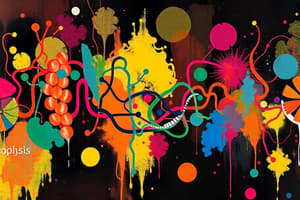Podcast
Questions and Answers
What is the primary product of glycolysis?
What is the primary product of glycolysis?
- Pyruvate (correct)
- ATP
- NAD+
- Glucose
Glycolysis results in an overall net production of four molecules of ATP.
Glycolysis results in an overall net production of four molecules of ATP.
False (B)
What two products are formed from NAD+ during glycolysis?
What two products are formed from NAD+ during glycolysis?
NADH
Glycolysis occurs in the __________ of the cell.
Glycolysis occurs in the __________ of the cell.
Which metabolic process is NOT one of the main sets of metabolic processes mentioned?
Which metabolic process is NOT one of the main sets of metabolic processes mentioned?
Gluconeogenesis is simply the reverse of glycolysis.
Gluconeogenesis is simply the reverse of glycolysis.
How many molecules of ATP are produced net from one molecule of glucose during glycolysis?
How many molecules of ATP are produced net from one molecule of glucose during glycolysis?
Match the following processes with their outcomes:
Match the following processes with their outcomes:
Which process is primarily responsible for ATP production during aerobic respiration?
Which process is primarily responsible for ATP production during aerobic respiration?
Glycolysis is the only metabolic pathway involved in energy production.
Glycolysis is the only metabolic pathway involved in energy production.
What is the main carbon source for aerobic cellular respiration?
What is the main carbon source for aerobic cellular respiration?
The combustion of glucose produces _____ and _____ as byproducts.
The combustion of glucose produces _____ and _____ as byproducts.
Match the following metabolic pathways with their functions:
Match the following metabolic pathways with their functions:
How many molecules of carbon dioxide are produced from one molecule of glucose during aerobic respiration?
How many molecules of carbon dioxide are produced from one molecule of glucose during aerobic respiration?
Dysregulation of plasma glucose concentrations can lead to diabetes.
Dysregulation of plasma glucose concentrations can lead to diabetes.
What is one of the critical roles of glycolysis in metabolism?
What is one of the critical roles of glycolysis in metabolism?
What is the net production of ATP during glycolysis?
What is the net production of ATP during glycolysis?
Under anaerobic conditions, pyruvate is converted to ethanol in humans.
Under anaerobic conditions, pyruvate is converted to ethanol in humans.
What is pyruvate converted into during aerobic respiration?
What is pyruvate converted into during aerobic respiration?
During fermentation, pyruvate is ultimately converted to __________ in yeast.
During fermentation, pyruvate is ultimately converted to __________ in yeast.
Match the following sugars with their components:
Match the following sugars with their components:
Which of the following is NOT true about gluconeogenesis?
Which of the following is NOT true about gluconeogenesis?
All disaccharides are converted to glucose-6-phosphate in the glycolysis pathway.
All disaccharides are converted to glucose-6-phosphate in the glycolysis pathway.
What does the human body primarily convert pyruvate into during anaerobic respiration?
What does the human body primarily convert pyruvate into during anaerobic respiration?
Which of the following is an anabolic process?
Which of the following is an anabolic process?
Gluconeogenesis can only start with pyruvate as the substrate.
Gluconeogenesis can only start with pyruvate as the substrate.
What compound is formed through the hydrolysis of ATP in the glucose synthesis process?
What compound is formed through the hydrolysis of ATP in the glucose synthesis process?
The primary role of glucose in the body is to serve as a source of ______.
The primary role of glucose in the body is to serve as a source of ______.
Match the following components with their roles in energy balance:
Match the following components with their roles in energy balance:
Which substrate is NOT a precursor for gluconeogenesis?
Which substrate is NOT a precursor for gluconeogenesis?
Energy homeostasis involves balancing inputs from nutrients and energy expenditure.
Energy homeostasis involves balancing inputs from nutrients and energy expenditure.
What is the macromolecule used for longer-term energy storage in the liver?
What is the macromolecule used for longer-term energy storage in the liver?
Which molecule is produced from dihydroxyacetone phosphate during glycolysis?
Which molecule is produced from dihydroxyacetone phosphate during glycolysis?
The second step of glycolysis is the investment phase.
The second step of glycolysis is the investment phase.
What type of reaction occurs during the isomerization of dihydroxyacetone phosphate?
What type of reaction occurs during the isomerization of dihydroxyacetone phosphate?
The equilibrium of the isomerization reaction favors the formation of __________.
The equilibrium of the isomerization reaction favors the formation of __________.
What is produced during the third step of glycolysis, also known as the payoff phase?
What is produced during the third step of glycolysis, also known as the payoff phase?
How many molecules of NADH are produced during glycolysis?
How many molecules of NADH are produced during glycolysis?
Match the following terms with their definitions:
Match the following terms with their definitions:
The hydrolysis of ATP to ADP shifts the equilibrium towards dihydroxyacetone phosphate.
The hydrolysis of ATP to ADP shifts the equilibrium towards dihydroxyacetone phosphate.
What is the primary purpose of phosphorylating glucose to glucose-6-phosphate in glycolysis?
What is the primary purpose of phosphorylating glucose to glucose-6-phosphate in glycolysis?
Which statement correctly describes the splitting of glucose-6-phosphate in glycolysis?
Which statement correctly describes the splitting of glucose-6-phosphate in glycolysis?
The conversion of pyruvate under anaerobic conditions results in the formation of acetyl-CoA.
The conversion of pyruvate under anaerobic conditions results in the formation of acetyl-CoA.
What type of reaction is catalyzed by glyceraldehyde-3-phosphate dehydrogenase (GAPDH)?
What type of reaction is catalyzed by glyceraldehyde-3-phosphate dehydrogenase (GAPDH)?
Under anaerobic conditions, pyruvate gets converted into ______ in the human body.
Under anaerobic conditions, pyruvate gets converted into ______ in the human body.
How does glyceraldehyde-3-phosphate dehydrogenase prevent the formation of a low energy intermediate?
How does glyceraldehyde-3-phosphate dehydrogenase prevent the formation of a low energy intermediate?
Match the following components of glycolysis with their respective roles:
Match the following components of glycolysis with their respective roles:
Which three steps are effectively irreversible in the glycolysis pathway?
Which three steps are effectively irreversible in the glycolysis pathway?
Flashcards
Glycolysis
Glycolysis
A metabolic pathway that breaks down glucose into pyruvate, producing ATP and reducing NAD+ to NADH.
Oxidative decarboxylation
Oxidative decarboxylation
The process of converting pyruvate to acetyl-CoA, releasing carbon dioxide and reducing NAD+ to NADH.
TCA cycle (Krebs cycle)
TCA cycle (Krebs cycle)
A cyclical series of reactions that oxidizes acetyl-CoA, generating NADH and FADH2, and producing ATP through substrate-level phosphorylation.
Oxidative phosphorylation and electron transport chain
Oxidative phosphorylation and electron transport chain
Signup and view all the flashcards
What is glycolysis?
What is glycolysis?
Signup and view all the flashcards
What is oxidative decarboxylation?
What is oxidative decarboxylation?
Signup and view all the flashcards
What is the Krebs cycle?
What is the Krebs cycle?
Signup and view all the flashcards
What is oxidative phosphorylation?
What is oxidative phosphorylation?
Signup and view all the flashcards
Gluconeogenesis
Gluconeogenesis
Signup and view all the flashcards
Energy Balance
Energy Balance
Signup and view all the flashcards
Aerobic Respiration
Aerobic Respiration
Signup and view all the flashcards
ATP (Adenosine Triphosphate)
ATP (Adenosine Triphosphate)
Signup and view all the flashcards
Glucose
Glucose
Signup and view all the flashcards
Oxidative Phosphorylation
Oxidative Phosphorylation
Signup and view all the flashcards
Anaerobic Glycolysis
Anaerobic Glycolysis
Signup and view all the flashcards
Pyruvate
Pyruvate
Signup and view all the flashcards
Acetyl-CoA
Acetyl-CoA
Signup and view all the flashcards
Fermentation
Fermentation
Signup and view all the flashcards
Ethanol fermentation
Ethanol fermentation
Signup and view all the flashcards
Lactate fermentation
Lactate fermentation
Signup and view all the flashcards
Energy Homeostasis
Energy Homeostasis
Signup and view all the flashcards
Anabolic Reactions
Anabolic Reactions
Signup and view all the flashcards
Catabolic Reactions
Catabolic Reactions
Signup and view all the flashcards
Blood Glucose
Blood Glucose
Signup and view all the flashcards
Phosphorylation
Phosphorylation
Signup and view all the flashcards
Glucose-6-phosphate
Glucose-6-phosphate
Signup and view all the flashcards
What is the splitting reaction in glycolysis?
What is the splitting reaction in glycolysis?
Signup and view all the flashcards
Glyceraldehyde-3-phosphate dehydrogenase (GAPDH)
Glyceraldehyde-3-phosphate dehydrogenase (GAPDH)
Signup and view all the flashcards
Hypoglycemia
Hypoglycemia
Signup and view all the flashcards
Hyperglycemia
Hyperglycemia
Signup and view all the flashcards
Lactate
Lactate
Signup and view all the flashcards
Irreversible steps in glycolysis
Irreversible steps in glycolysis
Signup and view all the flashcards
Glycolysis Step 2: Isomerization
Glycolysis Step 2: Isomerization
Signup and view all the flashcards
Equilibrium Shift in Glycolysis Step 2
Equilibrium Shift in Glycolysis Step 2
Signup and view all the flashcards
Glycolysis Step 3: Payoff Phase
Glycolysis Step 3: Payoff Phase
Signup and view all the flashcards
Substrate-Level Phosphorylation
Substrate-Level Phosphorylation
Signup and view all the flashcards
Glycolysis: Net Energy Gain
Glycolysis: Net Energy Gain
Signup and view all the flashcards
Glycolysis: Investment Phase
Glycolysis: Investment Phase
Signup and view all the flashcards
Study Notes
CBI 7: Glycolysis and Gluconeogenesis
- The production of ATP (energy) occurs through connected processes: glycolysis, oxidative decarboxylation, TCA cycle, and oxidative phosphorylation.
- Glycolysis and gluconeogenesis are key metabolic pathways relating to intracellular energy transfer.
- Glycolysis is a series of steps that break down glucose to produce pyruvate, NADH, and ATP.
- Gluconeogenesis is the synthesis of glucose from non-carbohydrate precursors.
- Gluconeogenesis is not simply the reverse of glycolysis, it uses alternative pathways to bypass irreversible reactions in glycolysis.
- Glucose is the main energy source for the body, especially for the brain.
Steps in Glycolysis
- Glycolysis takes place in the cytosol.
- Glucose is phosphorylated to glucose-6-phosphate which traps glucose inside the cell and activates it for further breakdown.
- Glycolysis involves 10 enzyme-catalysed reactions and is divided into three main steps, including the investment and payoff phases.
- Glucose is broken down into two molecules of pyruvate.
- The reactions produce 2 ATP, 2 NADH, and 2 pyruvate.
Fate of Pyruvate
- Under aerobic conditions, pyruvate is converted to acetyl-CoA, which enters the TCA cycle.
- Under anaerobic conditions, pyruvate is converted to lactate (in humans) or ethanol (in yeast/bacteria).
Gluconeogenesis
- Gluconeogenesis occurs mainly in the liver and adrenal cortex.
- The pathway is related to the conversion of non-sugar precursors into glucose, mainly pyruvate.
- The pathway has to bypass one or more irreversible step of glycolysis.
- It goes through different pathways to use different precursors, and thus avoid these irreversible steps. This happens through using alternative enzymes.
- Gluconeogenesis is important in maintaining stable blood glucose levels during prolonged fasting or starvation
Energy Balance and Regulation
- Energy balance involves catabolism (releasing energy) and anabolism (requiring energy) reactions that maintain the body's metabolic homeostasis.
- Blood glucose levels need to be regulated (between 4-8 mM), with both glycolysis and gluconeogenesis playing critical roles.
- Insulin and glucagon hormones regulate the rate of glycolysis and gluconeogenesis respectively.
- Fast regulation can be achieved by allosteric inhibition to control the enzymatic activity to avoid glycolysis and gluconeogenesis operating at the same time.
- Hormone regulation mainly controls the rate at which the enzymes required for these pathways are produced.
Studying That Suits You
Use AI to generate personalized quizzes and flashcards to suit your learning preferences.




